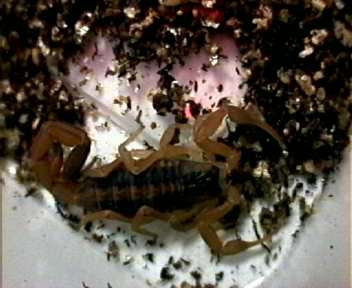
Picture of Centruroides vittatus
Scorpion Care
Why keep scorpions?
This is one question I hope all potential scorpion owner ask themselves before
reading further. WHY? If it is mainly for the morbid thought of keeping something very
dangerous or as a way of showing off your 'bravery', please think again. No doubt, the
above may add to the thrill of having them (which I admit does play a small part in my
interest) but you may well end up in hospital. What's worse, you may cause another to
be hurt for no reason than your folly. I do not want to be a self-appointed judge of
what's right or wrong but please give it serious thought.
So why keep scorpions? Many other reasons exists. For myself, it was the above which got me interested but it is their fascinating life history which got me hooked. I've also an unexplainable 'love' for these creatures. They are interesting to observe and very undemanding pets. They go about their own business and offers little moments of thrills at times. As you delve further into the hobby, some would feel an urge to let others understand their pets. They are also a cool subject to strike up a conversation ;-). Also, they are good research material given their peculiarity and medical importance. Much headway could be made as the present knowledge of scorpions is relatively sparse.
Decide for yourself ............
Scorpion do need our attention in captivity. Despite many reports substantiated or otherwise about their amazing ability to withstand extremes of temperature, starvation, thirst, overcrowding and even radiation, the most likely consequence of replicating unfavourable condition is the death of your scorpion(s)..........
So as not to make things too complicated for the amateur, I'll attempt to keep things systematic even though there is much overlap and possible exceptions
The care of scorpions is divided into sections:
Selection
Before you even purchase or decide to keep as pet wild or captive bred
scorpions, it is best to understand some basics of selection or you may end up with a
ticking timebomb!
(I strongly recommend buying from knowledgeable pet shop owners or dealers identified
species. This reduces the pressure on natural population and gives you a better chance of
having a safe pet)
General guidelines
1) Scorpions with slender claws are to be chosen with caution as most belong
to family Buthidae which contains some of the most venomous scorpions known. One of the
most common is the Texas bark scorpion, Centrutoides vittatus. It may be confused
with Arizona bark scorpion, Centruroides exilicauda (C.sculputarus previously)
which has been known to cause some deaths in Mexico in 1930-1960s. Stings of both C.exilicauda
and C.vittatus is very painful. Death from stings of related species like
Centruroides .limpidus, is not unknown. However, I must qualify that their venom is
not as potent as those stated in (2) and so responsible and careful beginners may still
keep them as pets.
.
Picture of Centruroides vittatus
2) Those with slender claws and fat, 'rough' tail is commonly called fat tail scorpion. The common name encompasses various species of genus Androctonus and genus Parabuthus but may be mixed up with genus like Hottentota. These are, in general, bad idea to keep unless you're a specialist or someone doing research on them. The reason is simple, most of us could not tell one from another and species like Yellow fat tail scorpion, Androctonus australis, stings is known to cause death in a small percentage of adults! They are quite aggressive and their venom toxicity to mouse is similar to that of cobra. They are, in short, too dangerous to keep as pets for the general public. Then again there are quite a few experienced responsible amateurs who keeps them. For the beginners, these are 'no-no.'
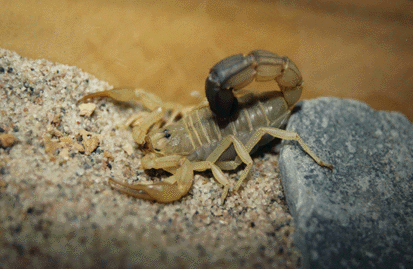
Picture of 'Saddam' (Androctonus australis) kindly provided by Boddan. Pet decision
is really your own.
3) Hadrurus sp.(Desert hairy scorpion), Hadogenes sp. (flat rock scorpion), Pandinus
imperator(Emperor scorpion), Scorpio maurus (Israeli gold scorpion) and
Heterometrus sp (Asian/giant forest scorpion) are quite suitable as pet due to their large
size, mild venom and mild deposition (not aggressive).
Of these, Emperor scorpion ,P.imperator, is most popular and is time proven to be
quite safe. My experience with (Asian forest scorpion) Heterometrus (spinifer?)
shows them to be ideal pets as well. However, I would not extend that to other Heterometrus
sp(especially H. swammerdami). They also appears more aggressive than Emperor
scorpion, P.imperator. Hadrurus sp and Hadogenes sp are reputedly
safe and quite placid. Scorpio maurus (Israeli golden) is aggressive but the stings
is generally mild.

Pandinus imperator : a suitable scorpion for beginners.
4) Small unidentified scorpions not showing characteristics in 1) or 2) may be kept but please do not handle them until they are identified as safe species to keep. There are many other safe scorpions to keep which are not listed here. In fact out of the 1100+ scorpions catalogued, less than 30 are truely dangerous. But why take chance........

Another 'safe' species for beginners is Vaejovis spinigerus

A possible setup using soil, mahogany wood, twig, pot and rocks
The best generalisation I can make is to simulate the scorpion's natural habitat.
A scorpion's foraging territory usually is not very big so a big container is not
necessary.
A plastic or glass tank is recommended. For a small scorpion (<30mm), a tank of length
200mm will suffice. For larger ones like Heterometrus spp (about 100+mm), a tank
larger than 400mm is preferred. A community of scorpions is not recommended unless the
owner is willing to take the risk of losing some.
It must be qualified that cannibalsim among species like Centruroides spp and Heterometrus
spp is rare. Also, Heterometrus spp. has been observed to co-exist well with
same species and Pandinus spp. A much larger tank (eg. >90cm) with
sufficient hiding place is recommended for a communal tank.
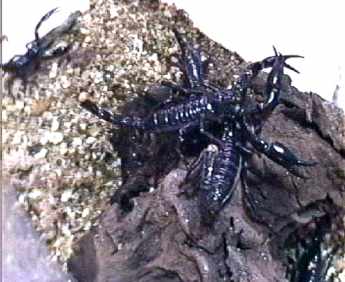
A bunch of irritated Heterometrus spinifer after being disturbed. Species like
this can be kept in small groups
Keep the container or tank covered!! With childrens around, please have a lock to
secure the tank to prevent accidents. The cover should ideally be at least twice the
scorpion's length away from the highest 'crawlable' point in your decor. To maintain
humidity in dryier regions in the temperate, the cover of the tanks should be quite dense
so as to trap humid air within the tank. This will be discuss later
The position of the tank should not be in the sun. It should be well balanced with little
chance of toppling over and kept in shade. Remember, even desert scorpions do not like to
be exposed to scathing sunlight. In fact, they hide in burrows (whether man made or self
dug) and come out at night to avoid the sun.
Give sufficient hiding place in the form of stable logs and rocks. Scorpions can get
crushed if these decors can be shifted. Leaf litter may be attempted but all my scorpions
except very young ones ain't impressed..... More about it in substrate
A heating unit in cold temperate countries can be used but make sure not to cook them.
Desert scorpion prefers a temperature of about 20-32 degrees centigrade while tropical
ones prefer 20-30 degrees centigrade. Temperate scorpions may be kept at slightly lower
temperature. In tropics, heating unit is an unnecessary expense. In an ideal setup, a big
tank (>90cm) and a heat gradient would be ideal (heater on one side).
If you want to have light to view your scorpion, please make sure that the light tube do
emit too much heat. Also the intensity should not be strong or the scorpion will either
hide all day or be stressed if no hiding place is provided. With their flourescent
property, many would be tempted to use ultra violet light. This is quite plausible as most
studies show little or no damage or change in life pattern for scorpions exposed to UV
except for reduction in flourescence over time. However, UV is damaging to our eyes and is
carcinogenic (ie. it increases your chance of cancer)
Substrate
One of the most controversial part with seeming disagreements with many
keepers. I give my two cents worth and you decide.
For convenience and cleaniness, fine desert soil is suitable for desert scorpions. Keep
the substrate dry and provide a water dish for drinking and maintaining humidity. Make
sure that the decor have a light, wide base log for the scorpion to dig under. This
provides two advantage: It gives scorpion security and prevents crushing. It gives you a
predictable place to search for burrow. Many will realise that the water dish is covered
by the 'disobedient' scorpion with sand soon. This is hard to avoid.
For tropical scorpions ,especially Heterometrus spp., loose potting soil is a
suitable medium. It allows for burrowing which they do in the wild. Keep it moist, not
wet. The biggest problem is that mites, parasites and fungus tends to grow especially if
you do not dispose of dead uneaten food. Mites look unsightly on scorpion and is not easy
to remove. Also there's a possibilty of stench. Greatest advantage of using soil for the
owner is that you can observe the intriguing burrowing behaviour of scorpions. The depth
of substrate is ideally one and half times your scorpion length or more. You should
provide water dish as well.
Paper towels is another possible medium and moisture of this substrate is easy to control
and cleaning and replacement is relatively easy. This may be considered for a large
collection of scorpions especially young ones.
For most scorpions, being as tolerant as they are, survival is not a good gauge of
success. Successful breeding is. With my limited experience in breeding, I think others
like David Gaban, Jay Stotzky, Richard etc of the Scorpion Enthusiast Mailing List are
better qualified to give their opinion on this.
What I do not really recommend is medium sized gravel. The ungues (two claw like things on
the legs) of the scorpions tends to be worn down or broken in such substrate.

Another area of big debate and I mean it. Handling is not necessary except when changing
substrate. This is precisely why selection is crucial. A fat tail scorpion sitting there
is best left alone though I know some who take chances.
For safe, non aggressive heavier species like Heterometrus spinifer. and Pandinus
imperator, hold the metasoma V (refer to anatomy) just below the telson. Metasoma V is
long (large margin of error). However, many can and do arch over and give you a good
pinch even when held in this manner. Be calm and allow it to cool down by giving its
leg something to hold on to. Be aware that handling scorpions with bare hands
carries certain risk for you and the scorpion.
For aggressive species or dangerous scorpions, use a tweezer with ends covered with soft
moist gauze. As before grasp the metasoma V gently. It is easy to use excessive or
insufficient force with a tweezer so a more ductile tweezer is preferred. Refer to picture
of Pascal Riewe using a forcep to hold an Androctonus australis.
Another safer method for scorpion and you is to lure it into open and then cover it
with a transparent cup. Slide a hard cardboard slowly and soon you'll have a scorpion in a
covered cup. So far so good, but keep the cup covered with something heavy so that the
scorpion cannot crawl out.
For safe species, you can let them crawl all over you, pet them and do all sort of funny
things.
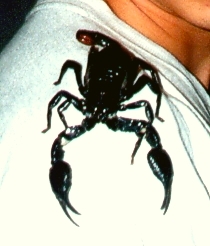 Heterometrus spinifer on a shoulder. As far as handling goes, I do not recommend that you do so. |
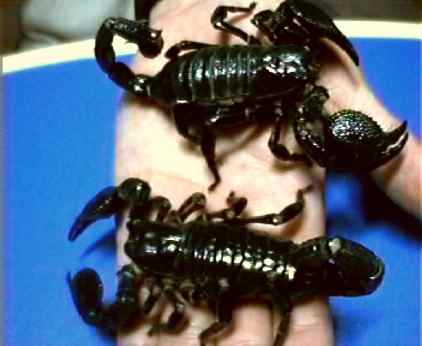 A couple of Pandinus imperator on a hand. The male is closer to the top. All scorpions should be handled with caution. |
Behaviour
Given the wide diversity in behaviour, I would attempt to make some general
behaviours observed mainly amongst the 100+ Heterometrus sp specimens I have
observed. Most scorpions are nocturnal and are active at night. Some hunt actively for
their food and most waits at their burrow for their prey to approach. However, juvenile
specimen tends to be more active in hunting their food. Juvenile scorpion are also
more likely to use their stings and exhibit aggressive tendency. Many scorpions
burrows and rest in these retreats most of the time.
It should be noted that males are generally more active while aggression varies greatly
between individuals.
Food
One of the most interesting moments in scorpion keeping is when feeding
them food. Different individual and species prefers different hunting method. Most stay
and wait till the food comes within range while others actively pursue their food. The Heterometrus
sp I've kept exhibit both. So what food do they take?
Large size scorpions can be fed adult crickets and mealworms though the latter is not very
popular with my pets. Grasshoppers or just about animals between 1/4 to 1/2 the size of
your scorpion can make suitable food.
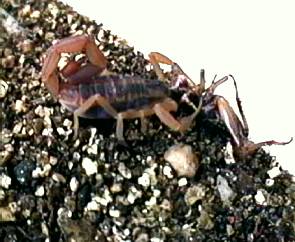
A Centruroides vittatus tackling a cricket nearly
its own size. Some species can be fed prey similar in
size to themselves but refer to the recommendation below
to be on the safe side. Once you're more experienced by
all means experiment.
The more exotic food includes spiders, large beetles, tree lizards, mice and snakes
but these are dangerous preys as they may turn the table. For slower species like Pandinus
imperator, it may be recommended to remove the legs or put in fridge to decrease
mobilty of crickets. Note that crickets and mealworms can attack newly moulted scorpion so
uneaten food is best removed. Also mealworms can severely destroy your logs and are
difficult to find once they burrow deep enough. Scorpions sometimes accept dead food and
may be persuaded to take them if you put them between their pincers.
Smaller scorpions can take smaller size crickets while baby scorpions take pinheads. In
short, crickets are time proven food. Selecting the correct size of crickets almost
guarantees success. Besides, scorpions fed on just crickets shows no signs of becoming
picky or illness. Alternatively, very small or young scorpions can be fed a large
dead cricket.
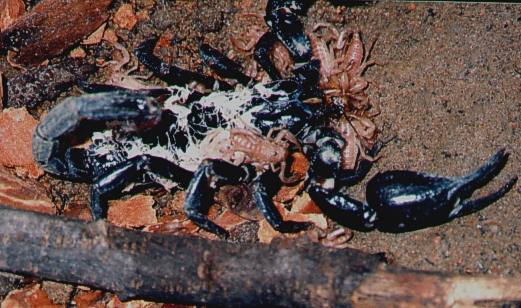
Here the mother Heterometrus spinifer killed and hold a adult cricket in its
chelicerae for the youngs to feed on.
I leave you here to explore the food they can take. Be prepared to
intervene when necessary.
As for frequency, adjust it to your scorpions needs. Younger scorpions need regular meals
(4 times a week). Older scorpions can be fed twice or once a week. Feed them till they
seem reluctant to take anymore. However, water should be provided at all times. Pregnant
or stressed scorpions (like newly caught ones) may not feed so check that all your setting
is correct and adopt a 'wait and see' attitude. It is interesting to note that Stahnke in
1954 has recorded a Hadrurus sp surviving 9 months wihout food! Another few studies
have scorpions surviving 13 months without food. This is not to be repeated with your
scorpions however. Most species and individuals need regular food supply to stay healthy.
It must be noted (contrary to what de Vosjoli wrote in 'Arachnomania'), scorpions would
not be overfed. They just stop eating when they are full. However, stray crickets
or other live foods may attack a resting scorpion especially when it has just moulted.
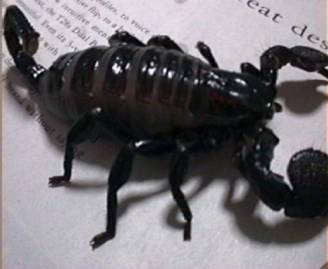
A grossly fat Pandinus imperator.
However, uncontrolled feeding does not seem to result
in death or otherwise amongst scorpions
As for timing of the feeding, you can feed it anytime but evening or night generally gives a better chance of feeding (especially active feeding).
Moulting and humidity
Scorpions grow in size by moulting (ecdysis). The moulting is a very
delicate period in which the scorpion is most vulnerable. It is the period in which
scorpion has one of the highest death (mortality). The old hard cuticle is shed and the
newer cuticle is soft. Many scorpions die when this process is not properly completed. It
is also a period in which scorpions is prone to parasites and infections. Even their food,
the mealworms and crickets may attempt to make a meal of your scorpions.
These are factors within our control. Successful moulting requires sufficiently high
humdity. However, excessive humidity may cause loss of limbs during moulting (if
extrapolated from theraphosids). Parasites and infection can be prevented with adequate
cleanliness while predation by its 'food' can be avoided if these are removed if not fed
upon.
As mentioned humidity is maintained either by a water dish or a moist (not wet) substrate.
A substrate which allows burrowing is even better. The cover of the tank will further help
to trap air moisture.
Parasites
Most common parasites is the mites. These are generally harmless but looks
unsightly on the scorpions. Some mites may colonise and block the spiracles of scorpion
resulting in a unwell scorpion. The most likely source is contaminated substrate (esp
vermiculite), decor (dead logs) and wild caught food material. To remove them takes a
long while and may not be productive. They are entrenched in depressions on the scorpions
and needs handling of scorpion to remove. It is easy to hurt the scorpion when doing so.
Using low concentration of alcohol on cotton bud may remove them easier but it may also
cause harm to your scorpion.
As far as I know, there are predacious mites (Hyoapsis sp)which preys on other
mites on sale. These would not stick to your scorpion. This biological 'warfare' may be
the best option yet but availabilty and cost is a problem.They are available in commercial
package in some countries.
Keep your tank clean is the best as the old cliche goes 'prevention is better than cure'
Mating/Birth
Refer to mating section in What is a scorpion. Also
refer to the sexual difference to identify the sexes. To allow for
mating, you must provide a large flat rock or smooth surface to allow deposition of
spermatophore by the male. Patience is what it takes
When the baby scorpions are born, leave it with the mother till they first moult. They
will feed on the reserves from the yolk. After that you may want to separate them as they
may start to eat on each other and the mother may mistakenly eat her own. Do not have
other scorpions within the same tank for the time being. Newly hatched scorpions after the
first instar will take pinheads (newly hatched crickets) They may also accept dead prey.
For Heterometrus and Pandinus sp, it is known to take care of the youngs
till the 3rd instar. Mortality is generally lower in scorpions kept with the mother for
the first instar.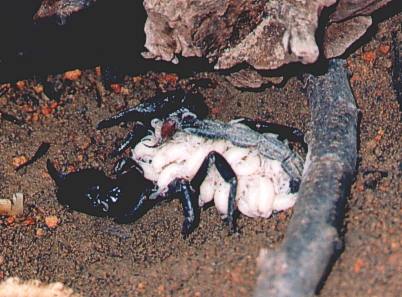
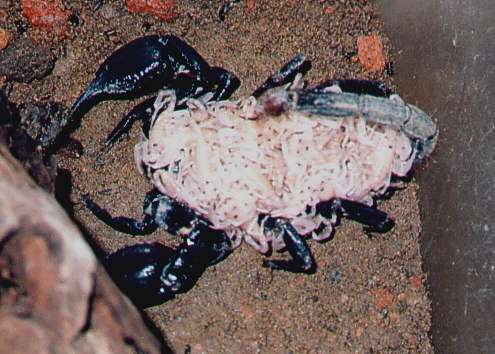
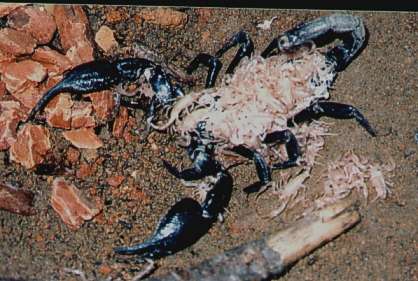
Heterometrus spinifer at 1st to 3rd instar
Care of Youngs
It is recommended to separate the youngs after 2nd instar for most species.
A paper towel for each container is recommended and this can be moistened to
provide water. Very small species like Centruroide vittatus youngs tends to get
stuck and drown in small water puddles or droplets and right moisture is crucial.
Dead prey could be provided till they are large enough to take larger ones.